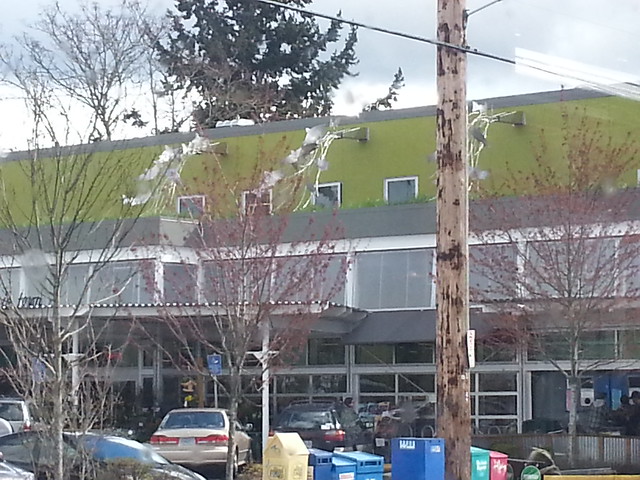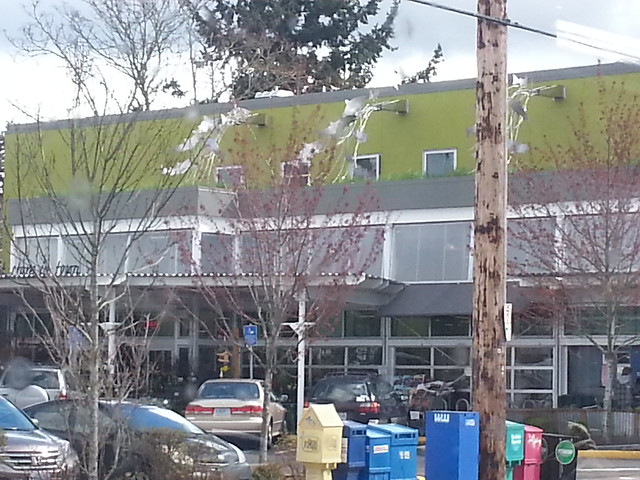Visitors to Portland's Waterfront Park are bound to notice the giant flagpole sooner or later, north of the Morrison Bridge and near the Battleship Oregon memorial. It seems like a strange thing to have in the middle of the hip, ironic, occasionally-war-protesting Portland of 2014, but there's an interesting historical story behind it. It seems that for a large part of 20th century, Portland prided itself on having the world's largest US flag, or at least the largest one that could be flown from a flagpole. In retrospect this seems sort of like the way tiny Midwestern towns are thrilled to have the world's largest ball of twine, except far more patriotic, somehow. But back in the day this was a great source of civic pride.
The story starts with a ship. From 1925 to 1942, Portland's waterfront was home to the old battleship USS Oregon, which played a key role in the Spanish-American War, and then was loaned (not given) to the city as a museum. When World War II broke out, the Navy decided the the old ship was more valuable as wartime scrap metal than as a historical monument, and it was towed away for dismantling. So as a super-patriotic (and non-metal-using) wartime replacement, the city decided to put up a giant 100' wooden flagpole, with a giant flag to go with it. It was first proposed in 1941, but wasn't completed until 1944 because people were kind of busy with WWII at the time.
The flagpole didn't always fly the giant flag, and the flag sometimes made guest appearances elsewhere. It showed up at the 1950 Shrine game (the all-star game for local high school football players) where it was referred to as the largest American flag in existence. I haven't seen any mention of that original flag's dimensions, but a larger one was acquired in 1956, with dimensions 15' by 10'.
Then in 1960, Hawaii became the 50th state, and a new 50 star flag was needed. Naturally this was a chance to go for an even larger flag, this time 36.5' by 24.5'. Which is a huge flag by any standard, and it was already too big to fly safely during stormy winter months, but there was already talk of creating an even larger one.
So in 1969 they got a truly gigantic flag, 62' by 42'. Which presented a problem, because the new flag was too large for the current flagpole, and it was obvious that it would become entangled with the Battleship Oregon mast or nearby oak trees if the wind ever happened to blow in the wrong direction. The article mentions it superseded a 45' by 30' flag from 1960, which I assume is the larger replacement mentioned in the earlier article. The article mentions the previous flag had rivals for the "World's Largest" title, but only mentions the Meier & Frank flag. That flag is bigger (60' by 48', pre-shrinkage) but it's never flown from a flagpole; they used to hang it over 6th Avenue during the Rose Festival, and in recent years it's occasionally been hung on the SW Morrison side of the Meier & Frank store (now Macy's) during major national events, most recently in the weeks after 9/11.
The new flag rarely flew, for safety reasons, and to make matters worse a 1972 letter to the editor pointed out that the flag's dimensions were all wrong. This may seem nitpicky and unimportant to anyone who was never a Boy Scout, but let me assure you the dimensions are very, very important. If the flag isn't shaped right, you can't fold it correctly in the official manner. Which is a problem because you also can't just set it down in a big pile somewhere; that would be disrespectful and you'd probably have to burn it then. So if it's the wrong dimensions, you're stuck carrying it around with you forever, pretty much. And as desirable as that is from a patriotism standpoint, it isn't always the most convenient thing when going about one's everyday life. So yeah, misshapen flags are the worst, basically.
In any case, 1980 rolled around, and City Hall (lobbied by the Rose Festival and veterans' groups) wanted a way to fly the giant flag safely. The American Legion had wanted to fly the big flag the previous year, but the usual safety concerns had cropped up again, and since this was the cusp of the Reagan era, the city couldn't simply tell them it wasn't practical, end of story; a way had to be found to accommodate the flag. Still, chopping down nearby oak trees wasn't an option, because it was 1980 and not 1944, so they decided to go for a taller flagpole instead, 135' this time instead of 100'. This caused delays, because finding a single 135' tree suitable for a flagpole takes a while, and the flagpole wasn't ready in time for that year's Veterans Day. The kinks were sorted out eventually and the flag flew on the following 4th of July.
If you look closely at the plaque on the flagpole, you'll see a mention of Gene Autry, the famous singing movie cowboy. It turns out there's a very prosaic reason for this: The flagpole was funded in part by donations from Golden West Broadcasting, the then-owner of KGW-AM and a couple of other local radio stations, and Autry was the company's chairman. So he was involved in the project to some degree, just not in a singing movie cowboy capacity.
The glory of the new flag and flagpole combo was short-lived, however, as a new contender disputed the city's "World's Largest" claim. In 1981, a larger 82' by 43.7' flag was raised at the offices of a Long Beach, CA bumper sticker magnate, of all places. Portland was still able to claim the largest flag on a wooden flagpole, which I guess is a sort of consolation prize, but the title of overall world's largest was gone for good. There was talk at the time of creating an even larger flag for Portland, but that doesn't seem to have gotten any traction. Portland quietly bowed out of the escalating vexillological arms race at that point, perhaps realizing giant flags had become the province of whackaloons and there's no competing with those people, and since then we haven't looked back. Cultural shifts here since 1980 make it unlikely that we're going to invest in a new record-setting flag or flagpole anytime soon. Portland has far more upscale and cosmopolitan things to burn money on these days, and we've consigned the entire monster flag phenomenon to the civic memory hole.
The arms race continued on without us, though. The bumper sticker king went on to invent "Superflag", which is much too big to actually fly from a flagpole, or to hang anywhere. Instead they just unfurl it at football stadiums, NASCAR races, etc., anywhere this sort of display would be welcome. There are actually several Superflags, available for rental in 3 sizes, up to 505' x 255'. If it's impossible to unfurl in a vertical position, there's a reasonable argument that it doesn't even count as a flag at that point. It's a very large something, but not a flag.
As for other large contenders, there's a 90' x 60' one that's been hung vertically on occasion on the George Washington Bridge in NY-NJ on occasion. As for flagpole-based flags, the largest seems to be a 114' x 65' one in Gastonia, NC, which weighs only 180 lbs, which is amazingly light if that's an accurate number. That flag seems to have a steel flagpole, though. So it's possible we still have a claim to the on-a-wooden-flagpole consolation prize, if anybody out there cares to pursue it for some reason.

